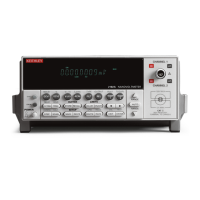Nanovoltmeter features
The Model 2182 is a 7
1
⁄
2
-digit high-performance digital nanovoltmeter. It has two input
channels to measure voltage and temperature. The measurement capabilities of the Model 2182
are explained in Section 2 of this manual (see “Measurement overview”).
Features of the Model 2182 Nanovoltmeter include:
• Ratio — Provides comparison readings between two voltage inputs. Ratio performs
V1/V2.
• Delta — Provides average difference of Channel 1 inputs. Delta performs
(V1t1–V1t2)/2.
• Enhanced Delta, Pulse Delta, and Differential Conductance — The following tests
can be performed when using a Model 2182/2182A with a Model 6220 or 6221 Current
Source:
— Delta - Uses a square w
ave output and a 3-point measurement algorithm to cancel
the effects of thermal EMFs.
— Pulse Delta (6221 and 2182A only) - Provides a pulse output and a 3-point (or
2-point) measurement algorithm for testing of temperature sensiti
ve Device Under
Test (DUT).
— Differential Conductance - Uses a dif
ferential current output and a 3-point moving
average algorithm to perform differential measurements.
• mX+b and Percent — These calculations provide mathematical manipulation of
readings.
• Relative — Null offsets or establish baseline values.
• Buffer — Store up to 1024 readings in the internal buffer.
• Limits — Set high and low reading limits to test devices.
• Internal Scanning — Scan the two input channels of the Model 2182.
• External Scanning — Scan the channels or matrix points of K
eithley Model 7001/7002
switching cards.
• Setup Storage — Two instrument setups (user and factory defaults) can be saved and
recalled.
• Analog Output —
With analog output gain set to one, a full range input will result in a
1V analog output.
• Remote Interface — The Model 2182 can be controlled using the IEEE-488 interface
(GPIB) or the RS-
232 interface.
• GPIB Programming Language — When using the GPIB, the instrument can be
programmed using the SCPI or Model 182 (DDCs) programming language.
• Closed-cover Calibration — The Model 2182 can be calibrated from either the front
panel or the GPIB.
1-6
Getting Started

